Carcassonne is one of the classic modern board games. Published in 2000, Klaus-Jurgen Wrede’s board game behemoth has sold over 12 million copies, been officially translated into 22 languages and reached an all-time high of #2 in the rankings on BoardGameGeek. It’s no exaggeration to say that Carcassonne has changed the landscape of tabletop gaming forever.
To celebrate this incredible game, Meeple Mountain is proud to present the 21 most important and influential moments from 21 years of Carcassonne.
The Moment of the Meeple (2000)
Perhaps the most famous image of the modern tabletop hobby, meeple are an iconic and influential design. Squat and colourful person-shaped playing pieces, they’ve appeared on everything from t-shirts to cushions, earrings to Christmas decorations, wedding cakes to café names and, of course, websites.
Yet meeple, both the name and the shape, didn’t exist before Carcassonne.
It was during the game’s rapid development that Bernd Brunnhofer (founder of Hans im Glück, Carcassonne’s publisher) and wood manufacturer and token-creator Mr. Seidenstücker designed the iconic player pieces. The rules referred to them as ‘Followers’ (‘Gefolgsmann’ in German), which become highwaymen, knights, monks and farmers when placed on the game’s roads, cities, monasteries and fields.

It wasn’t until after Carcassonne’s release that American gamer Alison Hansel came up with the portmanteau word ‘meeple’ in November 2000, by combining the words ‘my’ and ‘people’*. Yet even then it took many years before Carcassonne’s rules actually referred to the pieces as meeple, an expansion in terminology that was long overdue.
These days the term meeple is a synonym for any board game figure representing the player in any game, including the other 12 unique player pieces found across Carcassonne’s various expansions. Of course, there’s debate about whether all those 12 pieces count as meeple. For instance, the official stance from Hans im Glück is that mayors and wagons from the Abbey & Mayor expansion are meeple but the barn is a special figure – it doesn’t follow the usual rules of deployment, doesn’t affect the majority and can’t be eaten by the dragon or captured by a tower. Yet it remains a figure representing the player in the game so… technically it’s a meeple.
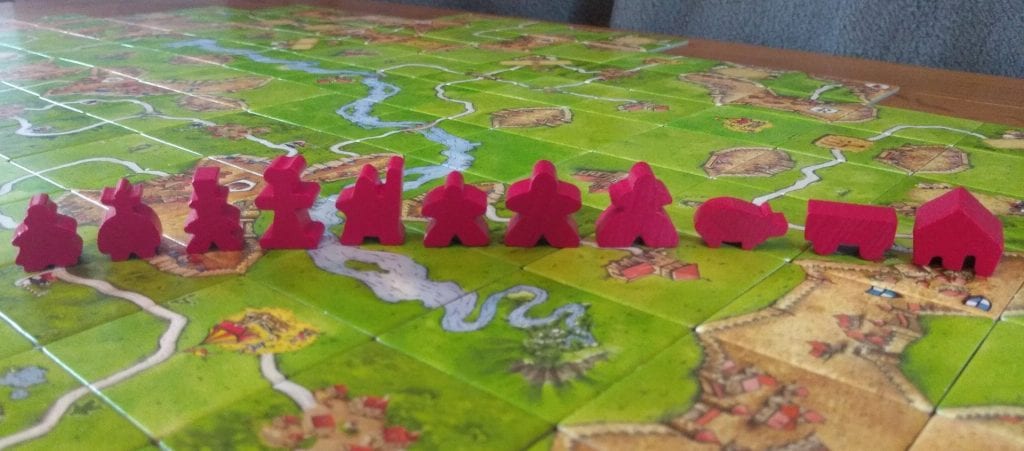
Further trivial trivia is whether more than one figure would be meeple or meeples? Lexico says that the plural is meeples, whilst Wiktionary and Grammarist say either form is fine. Hans im Glück themselves have stated that meeple is a single tantum (a noun with no plural form) “as the etymology of the word (“People”) already indicates a plural” and therefore it’s meeple, no matter how many you’re talking about. As for the collective noun for meeple… there isn’t one. Perhaps it should be a mountain of meeple?
*There are two alternative origin stories for the word meeple: the pieces look like a maple leaf and are made from maple wood. Both theories are widely felt to be incorrect, although maple is a common wood for making meeple, along with beech, cherry and basswood. Check out our interview with Panda Game Manufacturing to find out more about how meeple are made.
The Moment of First Expansion (2001)
As every river starts from a single spring, so too did the flood of Carcassonne expansions. Specifically with2001’s The River, a series of 12 tiles that depict the course of a river from a spring to a lake. Now typically included with the base game, The River started life as a mini-expansion given away at trade fairs.
Of course, as is the way with many Carcassonne expansions, there isn’t just one river. The River II arrived in 2005 as a mini-expansion (subsequently bundled as part of 2008’s Count, King and Robber) and includes features from other expansions (including a volcano for the dragon) as well as a junction that splits the river into two directions.
Think we’re done? Oh no! The River III is an update of the original river, with the same layout but including sheep and vineyards from the Hills & Sheep expansion. But is it a reprint or a separate expansion entitled to the suffix ‘III’? Well, Hans im Glück themselves seem to think there’s enough distinction – the version of The River included in 2014’s Big Box 5 has three ripples as its expansion indicating watermark rather than just one.
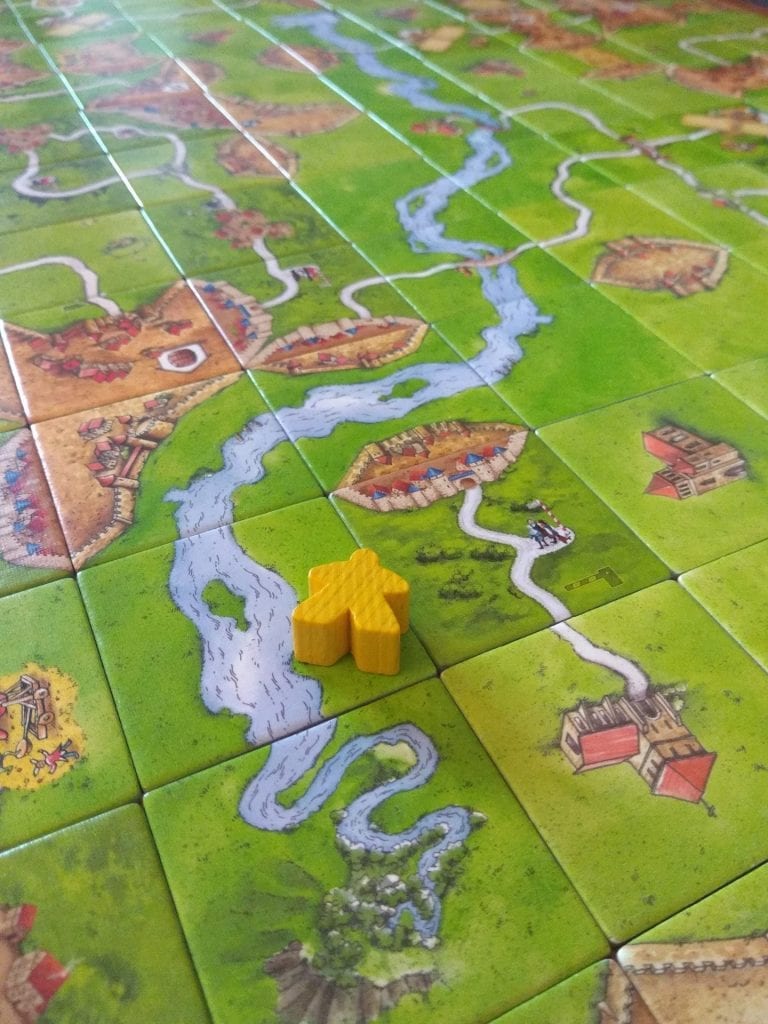
And we’re still not done because news of the 20th Anniversary Edition of the game suggests it will include five additional river tiles which could be a fourth expansion to The River. Although if we’re discussing additions to a river rather than complete rivers with beginnings and ends then there are two tiles in the 2006 Games Quarterly mini-expansion so…
Interestingly, these days The River has some competition over its claim as the first expansion. Since the reboot of Carcassonne in 2014, farmers are introduced as part of the Supplementary Rules, along with The River and the mini-expansion The Abbot. Traditionally considered an integral part of the base game, the rules for fields and farmers were moved to make Carcassonne even more accessible for new players. Farmers could now be considered as an expansion, which would make them the very first Carcassonne expansion.
As we’ll see later on, it’s far from the first time the rules for farmers have been changed.
The Moment of Victory (2001)
The Spiel des Jahres are the tabletop hobby’s equivalent to the Oscars*, widely recognised as the most influential global awards for board and card games. Whilst there are two other categories (Connoisseur’s Game of the Year and Children’s Game of the Year) and the occasional special award, it’s the main Spiel des Jahres award (Game of the Year) that has the most impact across the hobby. Even just a nomination can more than triple sales, whilst winners may sell up to half a million additional copies as a result.
Carcassonne won the Spiel des Jahres in 2001, beating out competition from acclaimed game designers such as Alan R Moon, Uwe Rosenberg, Rüdiger Dorn and Reiner Knizia. According to the Spiel des Jahres website Carcassonne is “a flawless tactical placement game”, with one of its particular strengths being its replayability based on “the tactical considerations of the other players”. At the time of writing Carcassonne is the third most successful Spiel des Jahres winner in terms of sales, with over 12 million copies sold, trailing only Catan (32 million) and Rummikub (50 million).
The victory is also why we’re talking about Carcassonne’s 20th Anniversary in 2021 despite the game being published in 2000 – Klaus-Jürgen Wrede and publisher Hans im Glück mark their celebrations according to the Spiel des Jahres win in 2001, rather than Carcassonne’s release.
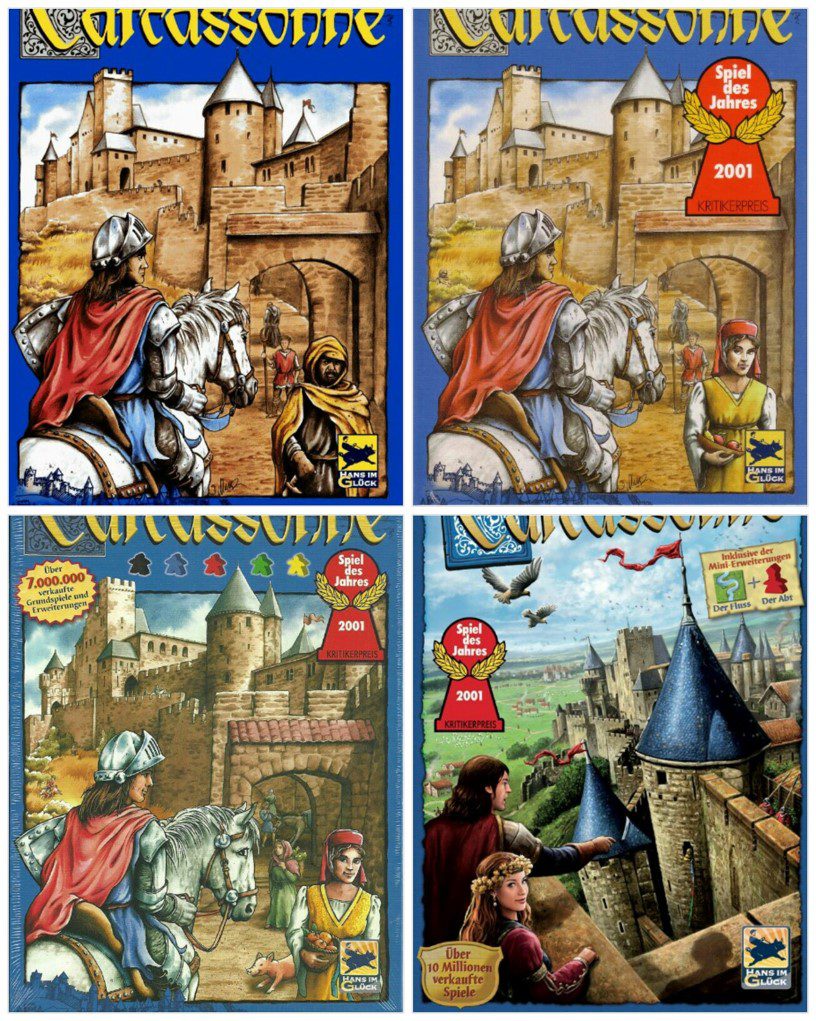
Whilst the Spiel des Jahres tend to prefer lighter, family-weight games, the Deutscher Spielepreis (German Game Prize) favours more complex ‘gamers’ games. In 2001 Carcassonne won both awards demonstrating that there’s a lot of depth behind this supposedly feather-weight family game. Only two games have managed to win both awards since Carcassonne – Dominion in 2009 and Azul in 2018.
Interested in the Spiel des Jahres? Check out Meeple Mountain’s Definitive Guide to the Spiel des Jahres.
*Given that both Klaus-Jurgen Wrede and the Spiel des Jahres are German it should probably be the Lolas.
The Moment(s) the Rules Changed (2001, 2002, 2005)
Somewhat controversially, the game that the jury awarded the Spiel des Jahres prize to in 2001 is subtly different to the game that we know as Carcassonne today (some have even called for Carcassonne to be stripped of its award). The rules have gone through two main changes since the first edition was released, with the differences coming down the scoring of fields and small cities.
Fields and farmers are the hardest feature for new players to understand. Fields score at the end of the game, with the owner of a field getting 3 points per completed city within that field. But in the first edition farmers were scored on a city-by-city basis – each city awarded points to the player with the most farmers surrounding that city. The Spiel des Jahres jury felt this was overly complicated and as a result the rules were changed soon after receiving the award.
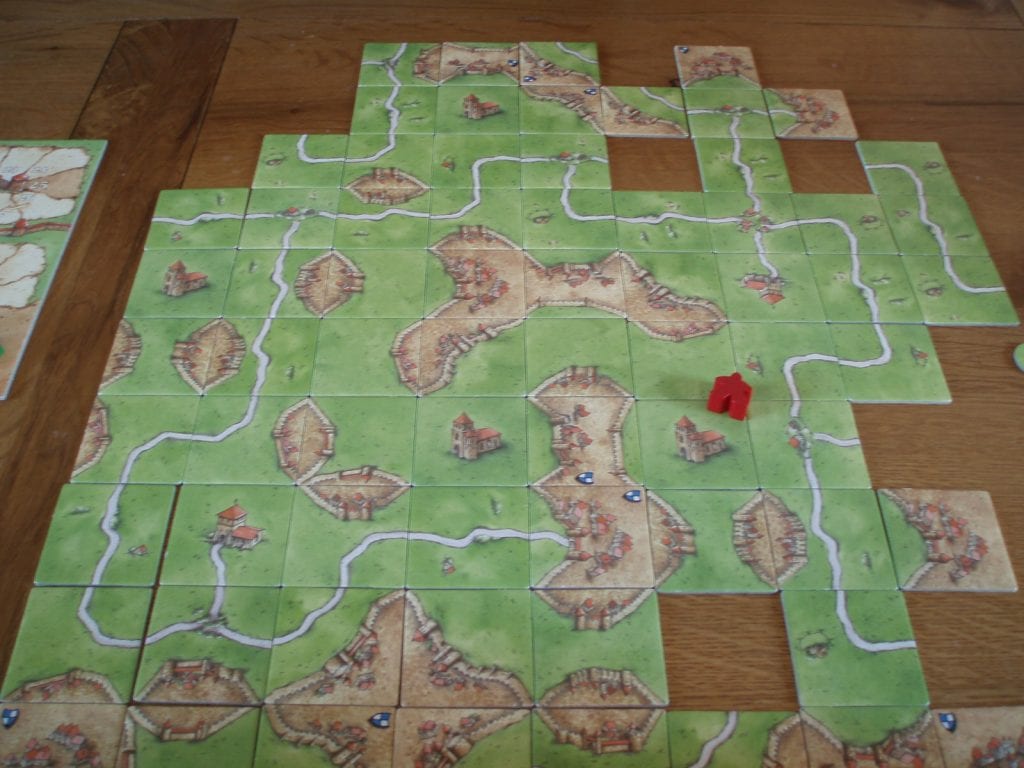
The second edition rules in 2001 had players scoring farmers on a field-by-field basis similar to what we use now, but each city could only be scored once – still a little awkward and fiddly. It wasn’t until the third edition rules in 2002 that farmers and fields were scored in the way we think of today. Curiously, the English language releases from Rio Grande Games didn’t change from the original rules until 2008, causing continued confusion over the scoring of fields.
These days cities award 2 points per tile – a city consisting of two tiles is worth 4 points. But this rule only came about in the third edition in 2002, prior to this small cities of only two tiles were worth just 2 points. The change to small city scoring makes the game more accessible and intuitive – new players don’t need to remember that different sized cities score differently.
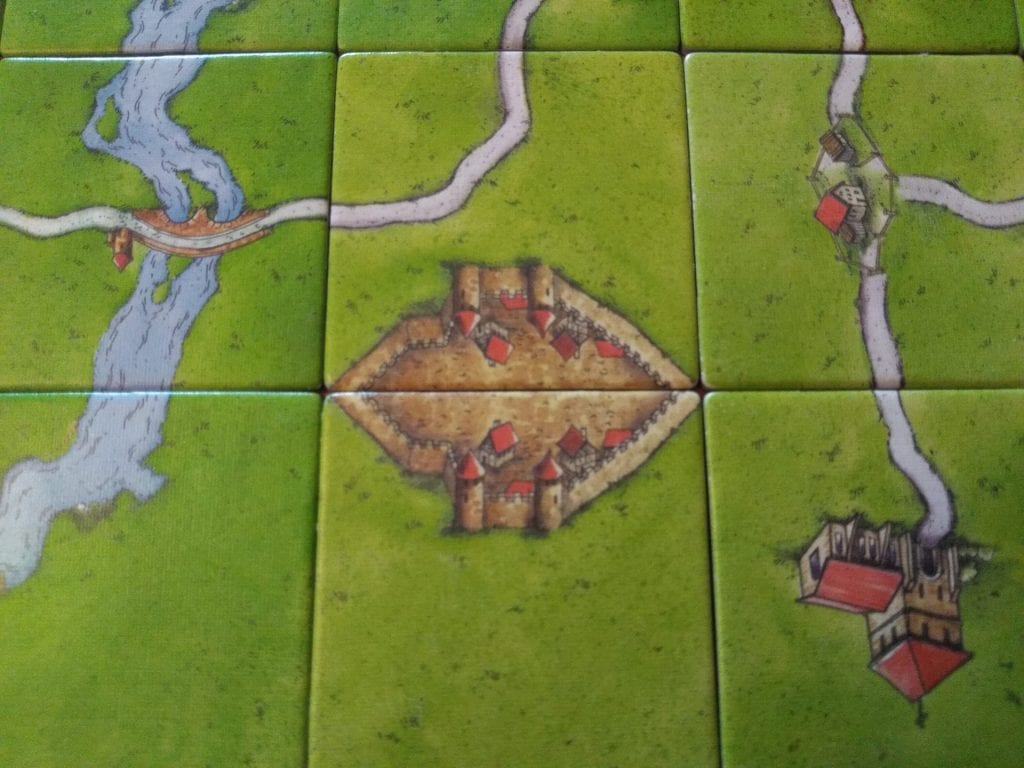
Together these rules updates changed some of Carcassonne’s strategy – it’s now reasonably profitable to create lots of small cities, especially if you own the field that they’re in. In 2002 fields got competitive!
As a result of the rules changes farmers can be said to be genuinely farming – growing a nice crop of cities! It’s clearly tiring work as in 2005 the rules were updated again to say that farmers should be placed lying down. Prior to this farmers were placed standing up (like the other meeple) with the rules from 2001 onwards providing a tip that you could lie them down to help distinguish them.
The Moment Carcassonne Went Digital (2002)
Board game apps and digital adaptations have become increasingly popular in recent years. Yet Carcassonne has a long history of cardboard being turned into pixels, leading the way into the digital sphere just as it’s led the way in many other areas of the tabletop world.
The first official Carcassonne videogame adaptation was released in 2002 by Koch Media. It ran on the PC and required a CD-ROM drive, at least 64 MB RAM and Windows 98, 2000 or XP (ah, those were the days!). There were AI opponents, the option for animated Followers, and the ability to play multiplayer locally or even online if you were lucky enough to have internet access at the time. Koch Media and Hans im Glück even ran a tournament in 2002 for players to construct the best Carcassonne bot.

Since then numerous official Carcassonne videogames have been released on PC and across consoles, including on the X-Box 360 in 2007 and Nintendo DS in 2009. Even Facebook had a Carcassonne game at one time. Of course, there have been plenty of unofficial and licensed adaptations as well, including the cheekily titled Toulouse, released in 2004.
Today if you want a digital Carcassonne fix you can simply use a smartphone, tablet, PC or game console. There are also sites like BoardGameArena, Yucata and Your Turn My Turn which all have versions of Carcassonne available to play, free or for a small fee. Curious about digital adaptations? Check out our review of the Carcassonne Android App.
So there we have it – the first five moments in our celebration and history of Carcassonne. Continue on as we discuss spin-offs, dragons and the doctor himself. And if that’s not enough you can read Meeple Mountain’s ‘A Conversationne – A Carcassonne Review’, our Carcassonne Strategy Guide, or even Meeple Mountain’s Carcassonne haiku.
The Moment Carcassonne Spun-Off (2002)
What’s the true sign of a successful franchise? Spin-offs of course! Carcassonne has loads, sixteen of them to be precise. The themes range from tropical island chains to Amazon forests, from discovering the New World to digging up its gold, and from the biblical to the galactic. We’ll see a few of them later on but there’s no better place to celebrate Carcassonne spin-off games than with the very first – Carcassonne: Hunters and Gatherers, released in 2002.
Set in the same region of southern France as its precursor, Hunters and Gatherers takes place thousands of years before the advent of cities and roads, in a time of mammoths, aurochs and sabre-toothed tigers (making it simultaneously Carcassonne’s offspring and ancestor). Players place tiles and meeples in the same way as before, scoring points for meadows, forests and rivers (Carcassonne’s fields, cities and roads). But this is no mere reskin of the original game. There are predators and prey in the meadows that cost/grant points, fish that score additional river points, and gold nuggets in the forests that give players bonus tiles with extra scoring opportunities. Players can also place fishing huts that score whole river networks at the end of the game.

Hunters and Gatherers is a little more complex than the base game, taking the same energy and gameplay but adding scoring wrinkles to create a fresh experience. And whilst antagonistic interactions used to just consist of stealing features or stranding your opponents’ meeple, the tigers also allow players to devalue each other’s meadows, making the game even more interactive.
The new theme changes the experience more subtly too. Players aren’t constructing cities and infrastructure but exploring a natural landscape. This sense of discovery enhances the shared storytelling that takes place between the competing players. It’s a more personal narrative, your meeple trying to survive and find food in their world. For a more detailed discussion of this aspect, check out the Manchester Game Studies Network’s article ‘Carcassonne and Collaborative Narrative’.
Out of print for a long time, Hunters and Gatherers has just been rebooted with updated artwork, rules, feature names (meadows have become grasslands, gold nuggets are now menhirs) and additional bonus tiles.
The Moment Carcassonne Got Competitive (2003)
Some people enjoy Carcassonne as a gentle game of laying tiles and scoring points. For others Carcassonne is a ruthless and brutal contest of skill and wits.
Whilst there were local and national tournaments beforehand, the world of competitive Carcassonne formally begun back in 2003 with the first International Carcassonne Tournament. 16 regional preliminary rounds in Germany and Austria along with 16 online tournaments held during 2003 whittled down the competition and on the 25th October 2003 the two best players from each round and tournament met in Germany to battle it out. 16 players made it through to the next day, by the end of which the first International Carcassonne Champion was crowned.
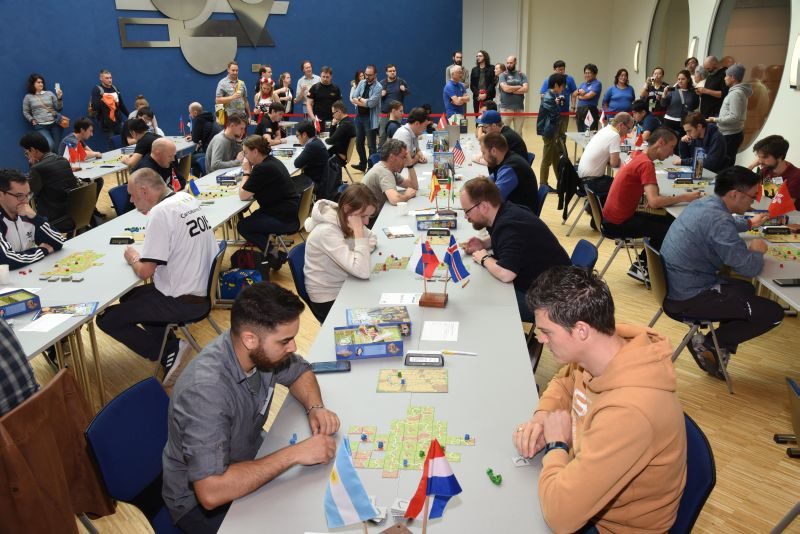
It wasn’t until 2006 that the official Carcassonne World Championships began. Held at the Essen Spiel Game Fair in Germany, 16 players from 15 countries (mostly from Europe but players also came from Taiwan, Malaysia and Australia) duked it out. The inaugural tournament was won by Ralph Querfurth from Germany who subsequently went on to claim the title another three times (in 2008, 2009 and 2010). It’s an impressive record when you consider that the next most successful competitor, Pantelis Litsardopoulos from Greece, has only won the Worlds twice.
Competitive Carcassonne is usually played head-to-head, although some tournaments have preliminary rounds using 4 player games, which can lead to more well-known expert players being ganged up on if they’re recognised by their opponents. No expansions are used and the field and small city scoring rules are the updated ones from the third edition from 2002, not the original ones.
Sadly, for obvious reasons, the Carcassonne World Championships didn’t happen in 2020, the first time in their history. At the time of writing there are plans for the 2021 Carcassonne World Championships to run in October 2021, with double the number of spaces (around 80) to make up for 2020’s cancellation.
The Moment Klaus-Jurgen Wrede Relinquished the Reigns (2003)
Whilst there had been input from other people (most notably Hans im Glück’s Bernd Brunnhofer), until 2003 all Carcassonne games and expansions had been designed by Klaus-Jurgen Wrede. But that changed in 2003 with the release of The Castle, a two-player spin-off game designed by famed board game creator Dr Reiner Knizia (Klaus-Jurgen Wrede wasn’t completely absent from the design process and is also credited).
Taking place in the walled city of Carcassonne itself The Castle takes the usual Carcassonne mechanics but traps them within the confines of the city walls, which duplicate as the score track. Unlike in other Carcassonne games, players build inwards from starting points on the walls and features placed next to each other don’t necessarily have to match. There are also game-changing bonuses available for landing on particular points on the score tracks, and being aware of where tiles aren’t being placed can be as important as being aware of where they are.
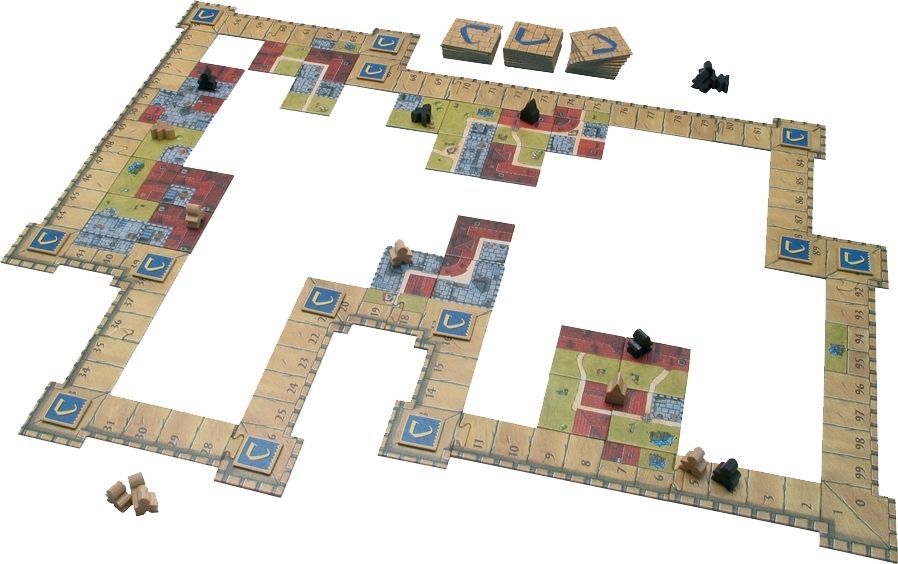
First announced in 2011 and only released as a print & play expansion for The Castle in 2013, The Falcon introduced eyries, kings, falconers and chapels. No simple print & play, it required players to create tiles, tokens and jigsaw-shaped castle wall pieces, as well as provide two types of meeple.
The Castle isn’t actually the only two-player version of Carcassonne. In 2017 Carcassonne Für 2 was released, reducing the numbers of tiles and meeple, as well as the tile size and thickness. It comes in a cute metal tin and is portable and much quicker to play. It only seems redundant when you realise that the original Carcassonne plays well at two anyway and a travel edition had already been released…
The Moment Carcassonne got Big (2003)
One of the rules of tabletop gaming is that if a game has a few expansions then at some point a Big Box version will come along, collecting the base game and expansions together.
Ignoring the inclusion of The River with the base game, the first time this happened for Carcassonne was as early as 2003: Carcassonne Limited Edition packaged together the base game with The River and the first two large expansions into one shiny golden box.
Whilst there were other subsequent collections, the first official Carcassonne Big Box was released 3 years later in 2006, combining the base game with the first four large expansions. Since then there have been a further five Big Box releases, each one including different combinations of the base game and its expansions. All of them include those first two large expansions – 2002’s Inns & Cathedrals and 2003’s Traders & Builders – a testament to how essential many players feel those expansions are.
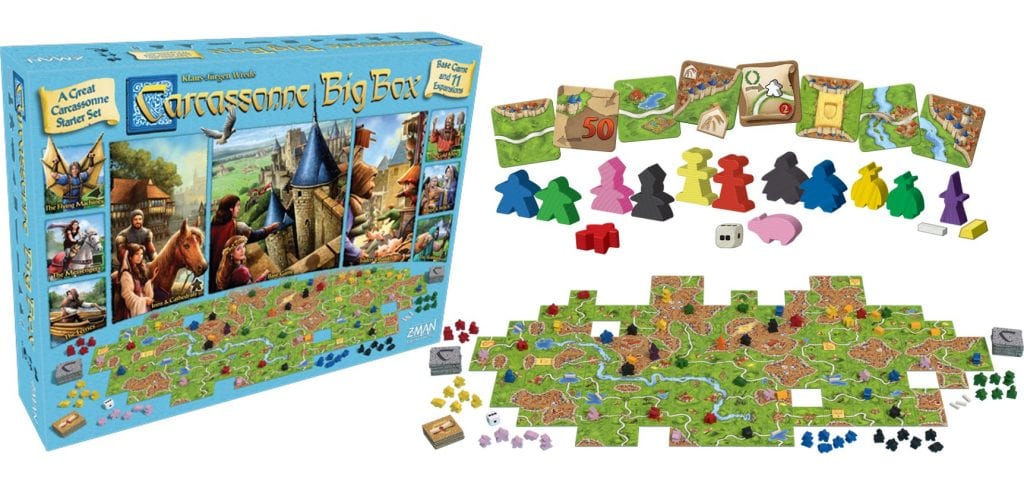
The Big Box series seemed to peak in 2014 with Big Box 5, which included four large expansions and sets of meeple for up to 8 players, the new colours being pink and purple. Pink was clearly popular as in the 2014 Carcassonne reboot pink has become the official 6th player colour, available in the Inns & Cathedrals expansion, re-released in 2015. In a move that couldn’t more appropriately symbolise the out-with-the-old attitude of the reboot, the original 6th player colour, grey, has been purged from the series.
The Moment of the Dragon (2005)
The first Carcassonne releases were thematically in keeping with the historic and medieval theme. They added mechanical depth and were fairly serious affairs. Po-faced even*.
2005’s The Princess & the Dragon was… not.
In addition to the titular dragon and princess the third large expansion chucked in volcanoes, magic portals and a fairy. In this expansion meeple are no longer safe – the dragon can eat them and the princesses can boot them out of cities. To combat this the fairy offers protection from the dragon and the magic portals allows players to place meeple on tiles other than the one they’ve just put down.
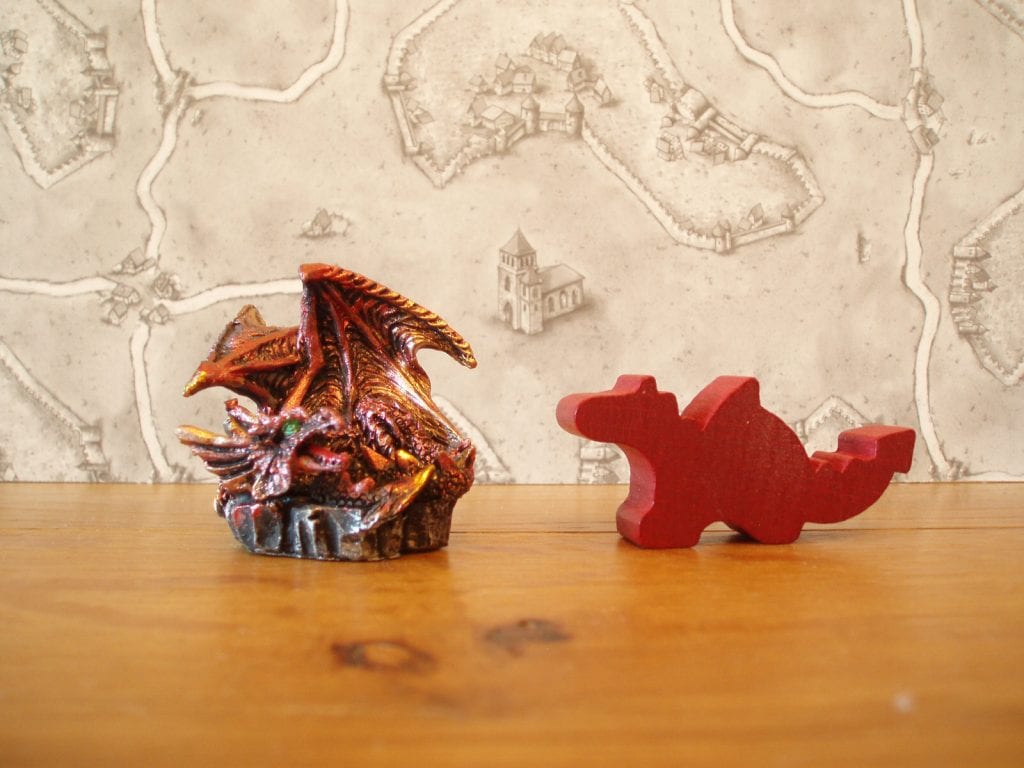
It’s all a bit chaotic. It’s not the moment Carcassonne jumped the shark (although that analogy was raised as early as the 8th January 2005, prior to the expansion’s release or publication of the rules…) but it definitely hopped a minnow. Whether you enjoy it or not depends on your appreciation of the fantasy theme or its impact on the game’s longer-term strategy. It caused a bit of a fuss when it first came out and it’s now recognised as an expansion that people either love or hate.
Someone who does love it is Klaus-Jurgen Wrede himself. Up until at least 2014 he’s stated that The Princess & the Dragon is his favourite expansion:
“Yes I like the princess and the dragon. The dragon is my most favourite figure. The dragon is always hungry.” (source).
Sadly for the dragon, in 2020 Klaus-Jurgen Wrede said it’s no longer his favourite as there are so many expansions that he likes and his favourite is whichever he’s working on at the time (source).
*An expression with a suitably French origin, deriving from ‘pot de chambre’, the French for chamber pot.
The Moments Carcassonne Diced with Two Kid’s Travel Cards (2007-2017)
Carcassonne has many spin-offs with different themes, but did you know there are also spin-offs that keep the medieval theme but change the mechanics? Welcome, my friend, to the reimplementations!
We’ll cover these chronologically, which also happens to be the order they’re ranked from understandable to really?
Travel Carcassonne (2007) – Nothing too exciting here. Tiles and meeple have shrunk and the score track is either printed on the back of the box or the tile bag, depending on the edition. It’s Carcassonne but dinky.
My First Carcassonne (2009) – Playable from aged 4 and up, this is the classic gateway game’s gateway to getting your children hooked on board games. My First Carcassonne is all about the roads – every tile has road connections on all four sides and most roads have kids depicted on them. The first player to place all their meeple on matching kids wins. Simple, engaging and the meeple have big round heads. Less simple is the nomenclature: Carcassonne Junior, My First Carcassonne and The Kids of Carcassonne are all the same game.

Cardcassonne (2009) – Yep, a card-based reimplementation of Carcassonne and a phenomenal bit of wordplay. You might expect that you’d be placing cards on the table to build up the familiar landscape, but you’d be wrong. Instead Cardcassonne sees players collecting sets of people, animals and buildings and scoring points differently for each type. Puns aside it’s probably the game in the whole series that feels most removed from the original Carcassonne.
Carcassonne: The Dice Game (2011) – In 2011 Olivier Lamontagne and Klaus-Jürgen Wrede achieved what many had predicted for years: a dice-based version of Carcassonne. Players roll dice to build cities, whilst also trying to collect meeple and avoid rolling catapults. It’s a light, super-quick race to reach a target number of points, with the most exciting element about it being the cute meeple-shaped tin it comes in.
Carcassonne Für 2 (2017) – This was covered earlier in so we won’t expand further here, other than to say that it still seems a little redundant.
So there we have it, five reimplementations of the classic game. So far only My First Carcassonne has been rebooted, with a fancy new edition released in 2020. Perhaps the other versions will follow suit in the future… or perhaps not.
And so moments six to eleven of our celebration and history of Carcassonne draw to a close. We’re at the half-way point in our 21 moments from 21 years of Carcassonne. Pause for a deep breath and a cup of tea, then read on for our continued celebration and history of all things Carcassonne!
The Moment Carcassonne Jumped the Shark (2008)
If Klaus-Jürgen Wrede flirted lightly with controversy with the release of The Princess & the Dragon, 3 years later he snogged controversy’s face off, married it and raised a small controversy family when he released The Catapult, the only major expansion not to get a reprint in the 2014 reboot.
Adding a dexterity element to the game, the catapult had players firing cardboard tokens at meeples, tiles and each other. Each time a tile with a fair on it is drawn, the catapult round starts. There are four possible catapult mini-games, from the obviously named ‘Target Hurling’ to the baffling ‘Seduction’.

Criticisms from Carcassonne purists about this expansion are numerous, with players complaining that it removes the strategic depth of the game, introduces a huge amount of luck, results in lost pieces, interrupts the smooth flow and quick turns, and is just plain silly. It probably doesn’t help that the wooden catapults are hugely inaccurate, meaning that the expansion doesn’t even reward skill and dexterity. At the time of writing the ‘hottest in-depth review’ for The Catapult on BoardGameGeek has the title:
“Fancy getting rid of your Carcassonne collection? Buy Carcassonne:Catapult!” (source).
The review doesn’t get much better from there.
However, look past the crashing wave of negativity that first greeted its release and you’ll find there are those who enjoy The Catapult for what it aims to be:
“Goofy fun once in a while” (source).
“The most enjoyable loss I have ever suffered” (souce).
“If you switch off your brain and enter into the spirit of it, it can be a good laugh” (source).
“This is my favourite guilty pleasure game… despite all of [it’s] flaws, it’s still really fun, and very entertaining.” (source).
And don’t just take their word for it. Respected tabletop writer Kurt Refling has said on record that he’d stake his reputation on the fact that it’s the perfect expansion.
It seems that if you want to add a silly element to the game it’s fairly (pun intended) harmless, and provided that everyone knows what to expect you’ll probably have a fun time with The Catapult. If you can get hold of a copy of it that is…
The Moment Carcassonne Celebrated by Crossing-Over (2011)
Why are we celebrating 20 years of Carcassonne in 2021 when the game is 21 years old? No, we didn’t forget to publish this in 2020 because of laziness, forgetfulness or even the pandemic. It’s because Klaus-Jürgen Wrede and publisher Hans im Glück mark their celebrations according to the Spiel des Jahres win in 2001, rather than Carcassonne’s release in 2000. So how have they celebrated previously?
Well, in 2011 Hans im Glück released the 10 Year Special Edition, a version of the base game that came in a meeple-shaped box with a meeple-shaped score board, translucent player meeples and a new expansion The Festival (this mini-expansion was later re-released in 2016 as part of the series’ reboot to celebrate 15 years since the Spiel des Jahres).
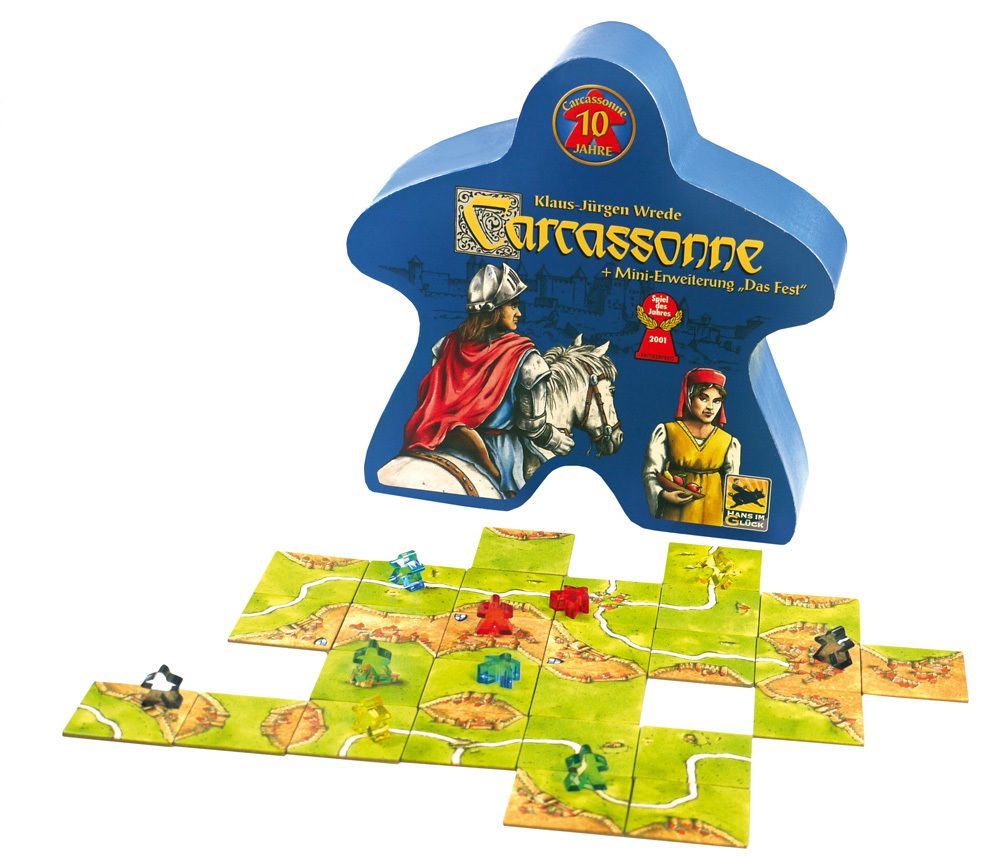
It’s safe to say that whilst the 10 Year Special Edition is a bit funky, it was also a tiny bit underwhelming for the game’s many fans who wanted something more.
So perhaps the most exciting part of the 10 year celebrations was the cross-over with 2009 Spiel des Jahres winner Dominion. Released for charity in 2011, the Dominion promo-card ‘Walled Village’ was a modification of Dominion’s ‘Village’ card, designed by Donald X. Vaccarino and with art by original Carcassonne artist Doris Matthäus.

Sadly there wasn’t a reciprocal promo-tile released for Carcassonne in 2019 to celebrate Dominion’s 10 year anniversary of winning the Spiel des Jahres.
Whilst we’re on the subject of age and anniversaries, Carcassonne is also the same age as the website BoardGameGeek, which was launched in January 2000 (about a year before Wikipedia, fact fans). BoardGameGeek is a long way from perfect but there’s no argument about its impact on the hobby over the past two decades. Perhaps nothing better symbolises the influence of the internet on the resurgence of the hobby than BoardGameGeek and its 2000 stablemate Carcassonne.
The Moment on Tabletop (2013)
Still in its infancy when Carcassonne was released, these days the internet is swarming with creators making cool and interesting content about board games. Meeple Mountain, whilst clearly the best, is just one of a plethora of websites, podcasts, YouTubers, Twitchers and Instagrammers. Yet only one has managed to make the art of watching other people play board games actually entertaining:
TableTop*
Created by Wil Wheaton and Felicia Day, TableTop was a web series that ran between 2012 and 2017. Across 4 series it showcased playthroughs of 79 games by internet personalities, comedians, actors, authors and even game designers (Munchkin creator Steve Jackson beat everyone at his own game). As the show progressed it attracted higher profile names: Alan Tudyk and Jon Heder trekked the Forbidden Desert, whilst Karen Gillian and Seth Green played pirates in Libertalia.

TableTop was a huge driver of the resurgence of board games, raising awareness of tabletop games beyond the hobby and boosting sales of the featured games shortly after each episode aired, something that became known as ‘The Wheaton Effect’.
On the 26th December 2013 ‘Carcassonne’, episode 16 of series 2, aired on the Geek & Sundry YouTube channel. What an (un)Boxing Day present to the world!
To date just shy of 1.5 million viewers (around 2 million if you include the Extended Episode) have watched Wil, YouTuber Jesse Cox, writer Nika Harper, and comedian Kumail Nanjiani battle it out across the landscape of Carcassonne. Excessively happy to come second, Nanjiani may well be TableTop’s only guest to feature in Time Magazine’s list of most influential people in the world.
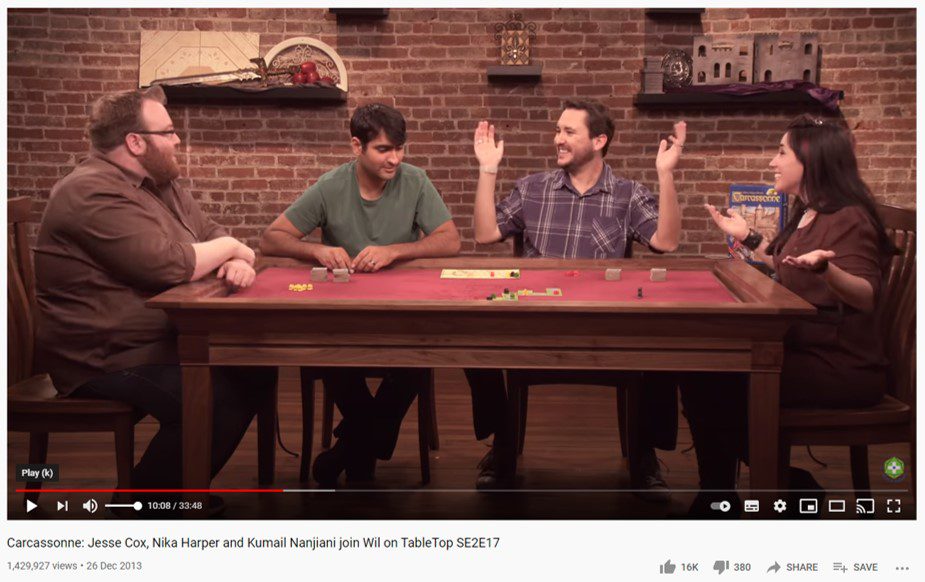
Carcassonne’s appearance on the show served as a final hurrah for the original edition of the game, with ‘The Wheaton Effect’ seeing sales rise following the episode. It’s a shame then that when Hans im Glück rebooted Carcassonne a few months later all those excited new owners were left with versions no longer supported by the publisher.
*Apologies to those who produce game playthroughs. Unless it’s a game that I’m already interested in and want to see a brief demonstration of then I’m unlikely to watch a playthrough. I’d happily watch an episode of TableTop regardless of what was being played.
The Moment Doris Became Anne (2014)
Carcassonne’s artwork is iconic, created by board game artist, designer and publisher Doris Matthäus. Renowned in the industry, Matthäus’ work can be found on three Spiel des Jahres winners and in 1998 she illustrated all four of the Deutscher Spielepreis (German Game Prize) winners – 1st, 2nd, 3rd and the Children’s Game award.
Yet sooner or later everything needs refreshing. By the time Carcassonne entered its fourteenth year the hobby was very different to how it was at the start of the millennium and Carcassonne’s muted colour palette was beginning to look a little dated. To compete with the flashy new games of the 2010s Hans im Glück decided to reboot the Carcassonne series.
How dramatic the 2014 changes were is a matter of personal opinion.
Nothing about the central gameplay of the base game really changed, other than a new mini-expansion included with the base game (The Abbot). Instead it was an aesthetic refresh that Carcassonne received, with Matthäus’ artwork replaced with illustrations by Anne Pätzke.

Despite Hans im Glück’s reassurances that the original and 2014 editions of the game and its expansions remained compatible, the changes were met with reluctance by many fans. Some even turned their backs on the game, stung by the publisher’s betrayal of them and Matthäus’ much loved artwork.
Yet after the initial grumblings most players have come round, either due to increased exposure to it or simple resignation that they don’t have much choice – Hans im Glück stopped releasing content for the older edition in 2016. Perhaps it helps that Klaus-Jurgen Wrede asked for the brown colour used for the cities to be lightened in the new edition, a move implemented from 2017 onwards that means the difference between new and old tiles isn’t as jarring.

To the casual player it’s not a huge change, but the brighter colours and increased contrast mean that it’s easy to spot the difference if mixing tiles. Most obviously, some of the roofs in the game’s cities turned from red to blue. More subtly the difference is a matter of scale and content. Matthäus’ original artwork portrayed a sparse and lonely landscape, the cities small isolated islands amongst a vast fabric of empty green. The viewer is higher, the details smaller. In contrast, Pätzke’s illustrations are busier, the landscape vibrant and alive. The scale is skewed too: cowsheds are the same height as city towers and, oddly, highwaymen.
The 2014 edition bustles where the original soothed, as if the landscape itself has developed and the population grown with the resurgence of the hobby.
The Moment of Secrets (2015)
Pope Innocent III wasn’t. Despite being honoured by the US House of Representatives and overseeing sweeping reforms of the Catholic Church, Innocent’s hands are soaked in blood. The Fourth Crusade was one of his, a 2 year campaign which resulted in the sacking of Constantinople. The Albigensian Crusade? Innocent’s too, a 20 year act of genocide to eliminate the Christian movement of Catharism which resulted in up to 1 million deaths and the formation of the Inquisition.
Which brings us to Carcassonne. Inhabited since 3500BC, by the High Middle Ages Carcassonne was a fortified city and a stronghold of the Cathars. Having slaughtered the entire population of Béziers in July 1209 (an event that produced the charming phrase “Kill them all; God will know His own”), the Crusaders turned to Carcassonne. They arrived at the city on the 1st August, cut off its water supply a week later and accepted its surrender on the 15th August. Spared a massacre, the citizens of Carcassonne were forced to leave the city in their undergarments (or naked, depending on which source you believe).
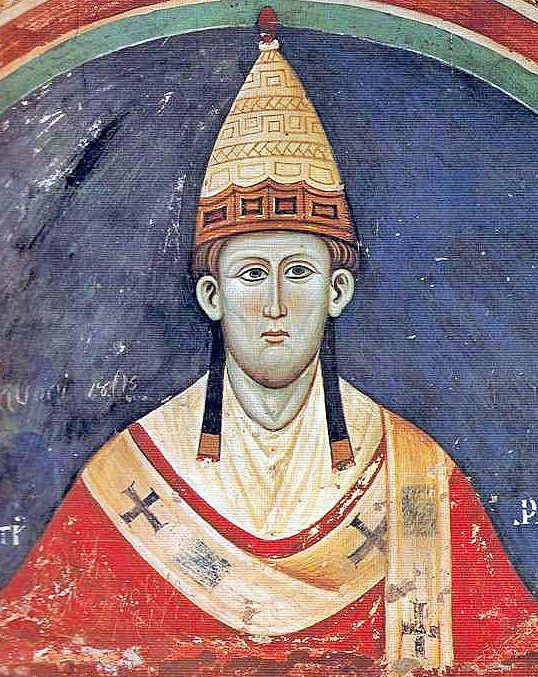
What does all this historical bloodshed have to do with the pleasant game of Carcassonne?
Everything. The origin of the game stems from a visit Klaus-Jurgen Wrede made to the region whilst researching the Cathars and the Albigensian Crusade for a novel. On returning from his trip Klaus-Jurgen Wrede put the novel aside and began designing the first prototypes, painting the tiles with watercolours.
Dirk Geilenkeuser at Hans im Glück saw the initial rules in early 2000 but it wasn’t quite the game of Carcassonne we recognise today. For a start there weren’t any monasteries, instead there were tiles that depicted just fields. Since placing these wasn’t especially fun for the player, monasteries were added. Players also had 3 more meeple to place but didn’t get any meeple back until final scoring. Most surprisingly, players could join claimed features, adding 1 or 2 meeple even if they already contained an opponent’s meeple. It was a harsher and more confrontational Carcassonne, in keeping with Klaus-Jurgen Wrede’s own gaming preferences.
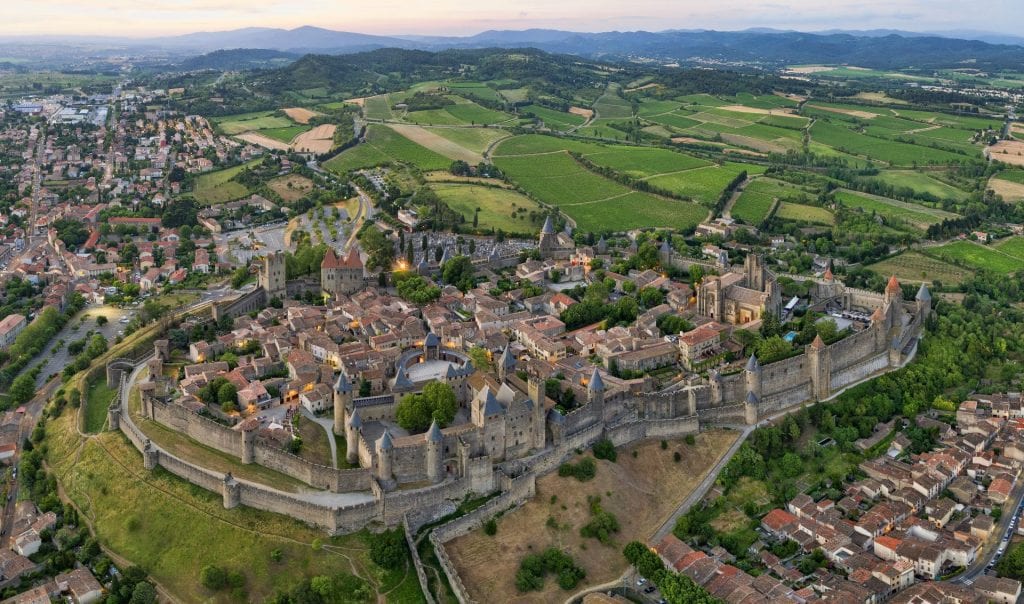
Carcassonne was accepted for publication in May 2000 and development was hurried to have it ready by October for Internationale Spieltage SPIEL – the Essen Game Fair. And the rest is history, covered (in excruciating detail) in this celebration of Carcassonne!
But what of the novel?
‘Das Geheimnis des Genter Altars’ (‘The Secret of the Ghent Altarpiece’) was finally published in 2015. It’s a thriller about the mysterious events surrounding the real-life theft of the Ghent Altarpiece in 1934 and the secrets that are hidden within the most stolen artwork of all time. Murder, theft, conspiracies, ominous organisations, enigmatic heroines and an adventure across Western Europe – it’s a far cry from sitting round a table and putting wooden figures on cardboard squares!
And so the penultimate part of our celebration of Carcassonne draws to a close. Continue on for our final five moments of Carcassonne where we discuss books, records and gold…Let’s waste no more time and crack straight on with our final five most important and influential moments from 21 years of Carcassonne!
The Moment Carcassonne Broke Records (2016)
If you have a few expansions for Carcassonne then you may well have played a game of Mega-Carcassonne. There’s no set definition just what Mega-Carcassonne should include but the general consensus is that it involves at least 3 of the larger expansions or any combination of expansions to create a tile set of around 150 or more. As the numbers of tiles and expansions increase, so too does the required table space and rules to remember, although some people eschew expansion rules to simply play the base game with a lot of tiles.
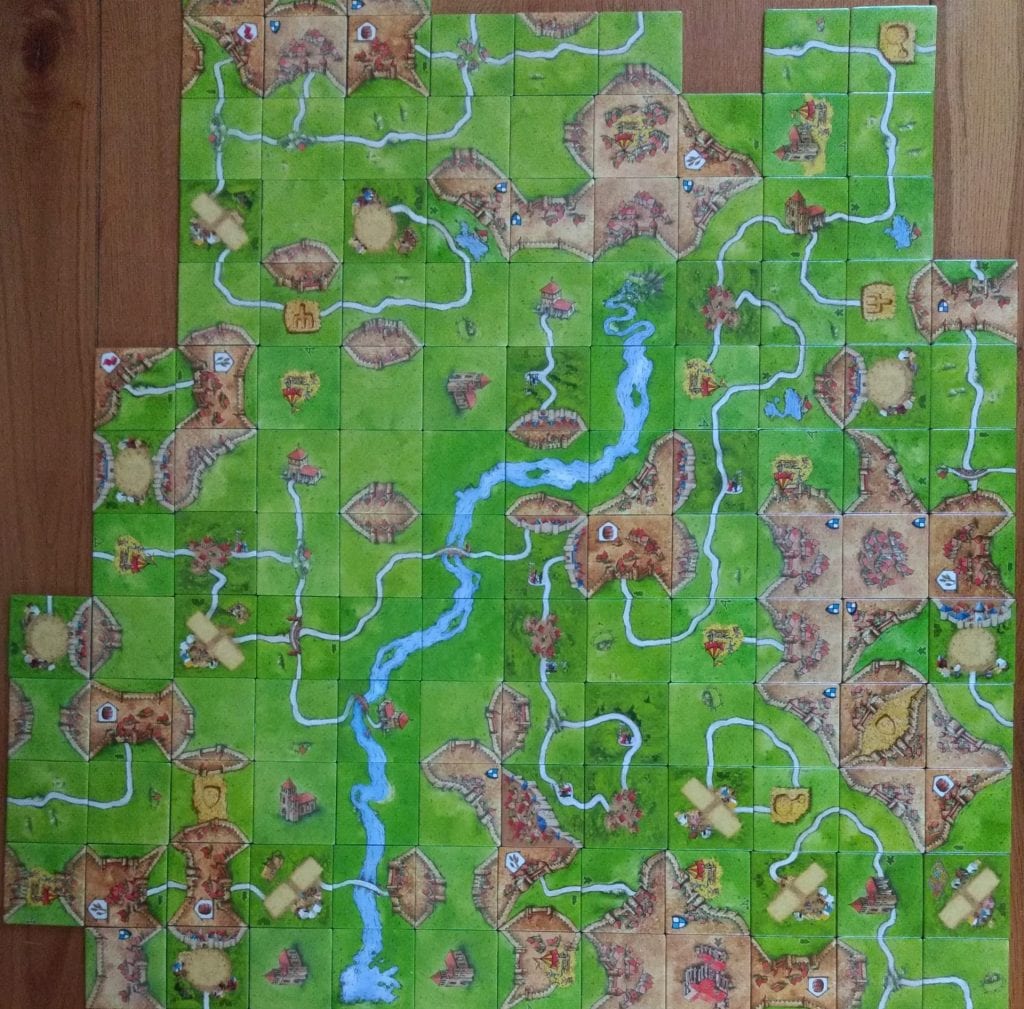
At the time of writing there are 538 single square tiles in original Carcassonne (the 2014 reboot currently has fewer tiles but that’s all but guaranteed to change in the future). Since each tile is 45mm by 45mm, the surface area you’d need to play the ultimate game of Mega-Carcassonne featuring every single tile would be just over 1m2. Which when it’s written down like that doesn’t really seem like a huge amount.
Happily we can content ourselves that the most mega game of Mega-Carcassonne was considerably larger.
Taking place as part of GothCon in Sweden in March 2016, the world record for the largest game of Carcassonne involved the placement of 10,007 tiles, supported by 48 tables. That’s a little over 20m2, a much more impressive feat. There are regions filled with nothing but monasteries, vast mutated cities and tangled knots of roads. The scores of the three players involved ranged from 11,886 to 9,402 points and the game included an 855 point city and a 35 point road.

The whole game took 25 hours, spread across the 3 days of GothCon, with two of the players sleeping on the floor of the game room. In order to finish the game during the convention compromises had to be made. Most expansion rules weren’t used in order to save time. Farmers weren’t placed to save meeple. There were phases of the game where players could take consecutive turns if they wished and one of the players was temporarily replaced by an interested passer-by so that play could continue late into the night.
Despite the changes to the game’s rules, this vast, record breaking game perfectly captures the spirit, popularity, scope and scale of Carcassonne.
The Moment of the Golden Expansion (2016)
Carcassonne is well known for having lots of expansions, and the term ‘expansion-fatigue’ is regularly applied to the game. Yet it doesn’t actually have as many as you might think.
At the time of writing BoardGameGeek lists 136 expansions (as of 20/04/2021), but around half of them are fan-made or country-specific bundles. WikiCarpedia is a more complete record but even then it’s not simple to keep track as many expansions have been released in different forms. For instance, 2004’s The Cathars was reprinted as Siege in 2008 with different artwork, and then again in 2013 as The Besiegers with extra tiles, updated artwork and different tile layouts. The rules for all three are the same so is that one, two or three expansions? Similarly, 2007’s Count, King and Robber bundled together four mini-expansions. Three had been individually released previously and the fourth was released the following year. Should we count that as one expansion or five? And what about single tile promos? Some of them change the rules, others don’t.
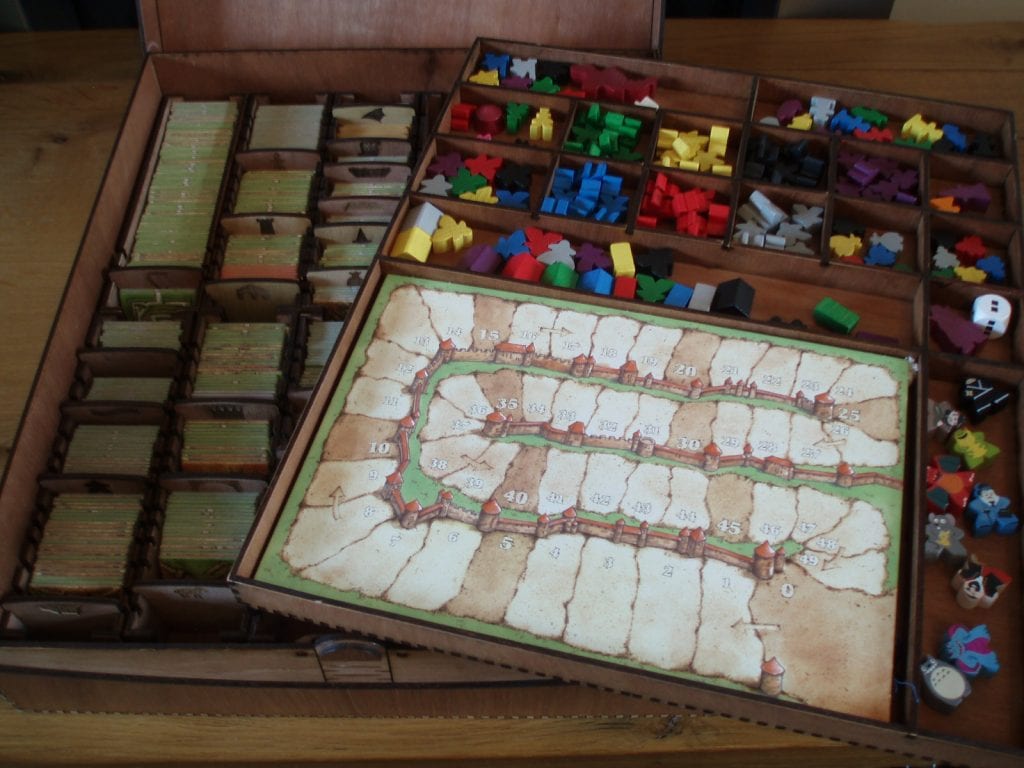
If we exclude duplicates between the original 2000 and rebooted 2014 versions of the game and include the five print & play/cut & play expansions, the various Maps/Map-Chips, and group each collection of promos into its own category (e.g. Spiel promos together and Russian promos together) then at the time of writing Carcassonne conservatively has 59 official expansions (The Cathars, Siege & The Besiegers counted as one, as is everything in Count, King and Robber).
So which is the Golden one, the 50th Carcassonne expansion?
Given the difficulty in just counting expansions it’s hard to know for sure. What we can say is that the 50th expansion was released in 2016, the final year that additional content for the original 2000 version of the game was being produced. 2016 was a busy year for Carcassonne and saw expansions that included watchtowers, fortune tellers, Japanese buildings, German cathedrals, Belgium and Dutch monasteries, and Russian folktales.

I like to think that the 50th expansion was The Labyrinths – the only expansion produced and released at the same time for both the original and 2014 rebooted versions of the game (The Fortune Teller was also released for both versions but is a print & play expansion). The Labyrinths is a single tile for each version featuring artwork from Doris Matthäus and Anne Pätzke. Roads enter the tile from all four sides and snake together creating a maze with the shape of a C. It’s rather lovely and a passing of the baton between Carcassonne’s old and new editions.
(Incidentally, the 50th fan expansion, according to BoardGameGeek, appears to be The Big Black Pig Escape, which is slightly less symbolic!)
The Moment Carcassonne Went to Print (2020)
At the ripe old age of 20, Carcassonne received another honour – a physical book. In 2020 ‘The Book of Carcassonne’ was published, written by author Steve Dee and Dan Chard, one of the UK’s top Carcassonne players and a Global Administrator of Carcassonne Central.
Contained within the 200 pages are strategy tips, advice from World Champions, thoughts on the expansions and spin-offs, and an interview with Klaus-Jurgen Wrede. There are pictures of optimal city shapes, discussions on creating traps and tile counting, silly Carcassonne jokes and insider knowledge from the competitive scene. It’s about as comprehensive and approachable as you could want from a Carcassonne strategy guide, even if a large proportion of the book talks about how to ‘kill’ the various features of your opponents, a term that feels offputtingly aggressive.

Happily, if strategy guides aren’t your thing but Carcassonne and books are then there are other options.
In 2009 Hans im Glück released a 500 copy limited edition of the standalone expansion Wheel of Fortune that came with a copy of ‘Carcassonne – Das Schicksalsrad’ (‘Carcassonne – The Wheel of Fortune’) by Helene Luise Köppe, a historical novel set in the early 13th Century about sisters living in Carcassonne who both love the same man. Köppel has since re-released the book as ‘Alix – The Wheel of Fortune’, which makes up the first volume of her six novel Cathar series ‘Daughters of the Devil’. ‘The Wheel of Fortune’ wasn’t even Köppel’s first novel set in Carcassonne either. That honour goes to 2005’s ‘The Secret Words’, which was retitled ‘The Gold of Carcassonne’ in 2007 and then re-released in 2018 as ‘Rixende – The Secret Words’, the fourth book in Köppel’s series. Not confusing at all!
Of course, if you like looking at books but not reading them then 2018’s Limited Special Edition may be for you. Designed to look like a medieval book, the Limited Special Edition is handcrafted using traditional craftsmanship and natural materials, including vegetable-tanned leather, hand-made paper and gold embossment.

It’s all about luxurious presentation, the contained game itself is just the base game with Doris Matthäus’ original artwork, the only notable thing being the folding score track. Of course, you’ll need a cool €649.00 but for that price you’re purchasing exclusivity – only 100 copies will ever be produced, with only 80 of those actually available for sale. Despite the high price, Hans im Glück say the profit margin is small and the price barely covers the production of the materials and the 55 individual steps that go into creating each copy.
The Moment Carcassonne Went Solo (2020)
Having spent the 2010s growing in popularity, board gaming saw a further resurgence as a result of the Covid-19 pandemic, with those in lockdown looking for alternative ways to pass the time. But what of those people stuck at home without gaming partners? Many turned to solo tabletop gaming, embracing the increasingly common single-player modes of their existing games.
In the spirit of helping fans continue to enjoy Carcassonne, no matter their situation, Hans im Glück published the official Carcassonne Solo Variant in April 2020 (the variant is also playable cooperatively).
To play solo the player alternates turns between three colours, their final total being that of their lowest scoring colour. Sounds simple but the rules add some tricky restrictions for how players place their meeple and score, which turn Carcassonne into a remarkably devious puzzle. Whilst there’s no ‘win’ condition (players are just trying to get the highest score) the rules do include a number of additional goals for players to aim for.
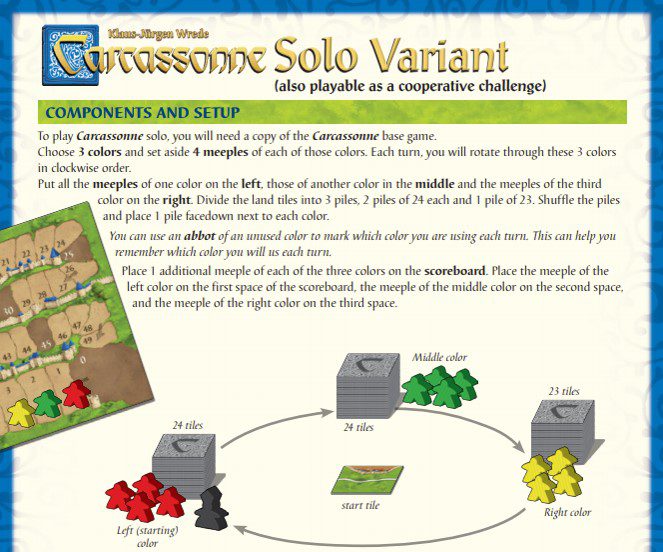
Of course, the tabletop hobby being made up of some very ingenious people, the official Carcassonne Solo Variant was late to its own party. A number of fan variants have long been in existence, including 2005’s Solitaire Carcassonne by Michael Gorely (in which the player plays consecutive sets of 20 tiles and repeatedly tries beat their previous score) and 2008’s Carc Island by John Fiore (which limits players to a 7×7 grid). In fact, solo variants are so common that in 2016 Decar over at Carcassonne Central started running an annual GenCant Solo Gaming Contest, using fabulously named variants such as The Abbot’s Walk (2017) and The Knave of Carcassonne (2018).
A solo variant wasn’t the only treat Carcassonne fans recieved as a result of the Covid-19. As part of the spate of free print-and-play expansions that were released in the early months of the pandemic, Hans im Glück released The Land Surveyors, a series of scoring tiles that modify the usual point values of different features, adding or subtracting points depending on which tiles are in play when the feature scores.
The (Brief) Moment on Top (2020)
What is the greatest tabletop game of all time? There’s no way of saying for sure – how do we even define great? Units sold? Reviewer score aggregate? The number of people who’ve played a game? The impact a game has on the hobby?
BoardGameGeek is the internet’s most comprehensive database of tabletop games, with users able to score their games and the ‘Geek Rating’ (a modification of the average rating) resulting in a ranked list of games from highest to lowest. Sadly Carcassonne never managed to reach the top spot, it peaked at number 2 and it’s currently placed at number 181 (which seems low but isn’t too bad for an older game).
But it’s not a perfect system. You can vote for games you haven’t played or that haven’t been released yet, it’s a list that prioritises newness (only nine older games sit higher than Carcassonne in the rankings, one of which is the 2,500 year old Go), and, in general, BoardGameGeek users tend to have ‘moved past’ the gateway game territory of Carcassonne.
Instead we could compare the number of people who have taken the time to score a game – a measure of how popular it is.

For well-over a decade Catan held the top spot of the ‘Most Rated Game’ on BoardGameGeek. Following months of catching up, Carcassonne finally claimed the title in the early summer of 2020… until Pandemic overtook them both a few weeks later. At the time of writing all three games have over 100,000 ratings, with only around 600 votes separating them.
What does this tell us? Very little, considering that Carcassonne has sold over 12 million copies, suggesting at least 24 million players, which means that a little over 0.4% of people who have played Carcassonne have actually rated it. But it was nice to see it top one of BoardGameGeek’s lists, if only for a moment!
The Moment in the Future (2021- )
So there we have it – 21 moments from 21 years of Carcassonne. What does the future hold for this tabletop giant? So far Hans im Glück have announced the 20th Anniversary Edition of the game, which includes a new 15-tile mini-expansion, 5 new river tiles, costume stickers to ‘dress’ your meeple with and lots of Easter eggs hidden in the tile art.
As for other anniversary celebrations or future releases, only Klaus-Jurgen Wrede and Hans im Glück know. What we can say for sure is that Carcassonne remains a fantastic game that is constantly adapting and innovating around its core system. At this stage there’s no reason not to predict another 20 years of success.
Feel like you need to read more about Carcassonne? Check out Meeple Mountain’s ‘A Conversationne – A Carcassonne Review’, our Carcassonne Strategy Guide, or even Meeple Mountain’s Carcassonne haiku.
References:
WikiCarpedia – The Carcassonne Complete Annotated Rules Wikipedia
Carcassonne World Championships



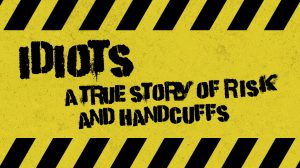

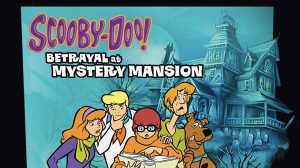





Excellent in-depth piece for Carcassone fans!
Thanks, I’m so glad you enjoyed it!